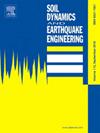Probability-deterministic broadband ground motion simulation method considering seismic hazard and physical processes
IF 4.2
2区 工程技术
Q1 ENGINEERING, GEOLOGICAL
引用次数: 0
Abstract
Near-fault seismic data are rare yet vital for site-specific analyses, but traditional methods struggle to capture their unique features. This study proposes a novel seismic ground motion prediction method that integrates the advantages of both probabilistic and deterministic approaches. This method incorporates the target structure's natural vibration period and evaluates all possible seismic risks within the potential seismic source zone rather than limiting the analysis to seismic response patterns under assumed scenarios. This approach establishes a series of probabilistically defined seismic events. A broadband hybrid seismic source model, which accounts for high-frequency random scattering, is introduced. The deterministic physics-based broadband hybrid method for seismic motion simulation simulates the low-frequency component (≤1 Hz) using the Spectral Element Method (SEM) and models the high-frequency component (>1 Hz) using a modified three-dimensional Stochastic Finite Fault Method (3D-EXSIM). The resulting output comprises a series of probabilistically significant broadband ground motion simulations designed for the actual site with varying return periods. The method is employed as a case study to analyze a rare earthquake scenario for a subway station (with a natural vibration period T = 1.0 s) in the Binhai New Area, Tianjin, to clarify and validate the rationality and advancement of this method for the seismic fortification of critical building structures in near-fault regions. The results demonstrated that this method is more reliable than the artificial ground motion synthesis model using the Uniform Hazard Spectrum (UHS) and effectively captures significant near-fault effects. This method is valuable for developing seismic codes and achieving urban planning and infrastructure protection in active fault areas.
考虑地震危险性和物理过程的概率确定性宽带地震动模拟方法
近断层地震数据非常罕见,但对于特定地点的分析至关重要,但传统方法很难捕捉到它们的独特特征。本文提出了一种综合概率法和确定性法优点的地震地震动预测新方法。该方法结合目标结构的固有振动周期,评估潜在震源区内所有可能发生的地震风险,而不是将分析局限于假设情景下的地震反应模式。这种方法建立了一系列概率定义的地震事件。介绍了一种考虑高频随机散射的宽带混合震源模型。基于确定性物理的宽带混合地震运动模拟方法使用谱元法(SEM)模拟低频分量(≤1hz),使用改进的三维随机有限故障法(3D-EXSIM)模拟高频分量(> 1hz)。由此产生的输出包括一系列概率显著的宽带地面运动模拟,这些模拟是为实际场地设计的,具有不同的返回周期。以天津滨海新区某地铁站(自振周期T = 1.0 s)的罕见地震场景为例,阐明并验证了该方法在近断层地区关键建筑结构抗震设防中的合理性和先进性。结果表明,该方法比使用均匀危险谱(UHS)的人工地震动综合模型更可靠,并能有效捕获显著的近断层效应。该方法对活动性断裂带的抗震规范制定、城市规划和基础设施保护具有一定的参考价值。
本文章由计算机程序翻译,如有差异,请以英文原文为准。
求助全文
约1分钟内获得全文
求助全文
来源期刊

Soil Dynamics and Earthquake Engineering
工程技术-地球科学综合
CiteScore
7.50
自引率
15.00%
发文量
446
审稿时长
8 months
期刊介绍:
The journal aims to encourage and enhance the role of mechanics and other disciplines as they relate to earthquake engineering by providing opportunities for the publication of the work of applied mathematicians, engineers and other applied scientists involved in solving problems closely related to the field of earthquake engineering and geotechnical earthquake engineering.
Emphasis is placed on new concepts and techniques, but case histories will also be published if they enhance the presentation and understanding of new technical concepts.
 求助内容:
求助内容: 应助结果提醒方式:
应助结果提醒方式:


